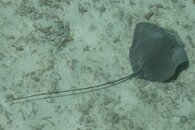You are using an out of date browser. It may not display this or other websites correctly.
You should upgrade or use an alternative browser.
You should upgrade or use an alternative browser.
What ray is this? [Maldives]
- Thread starter Crodol
- Start date
Please register or login
Welcome to ScubaBoard, the world's largest scuba diving community. Registration is not required to read the forums, but we encourage you to join. Joining has its benefits and enables you to participate in the discussions.
Benefits of registering include
- Ability to post and comment on topics and discussions.
- A Free photo gallery to share your dive photos with the world.
- You can make this box go away
joshjensen
Registered
bob kopki
Registered
Its a STINGRAY
walke121
Contributor
Where was the picture taken? Looks like a southern stingray but I can't be certain. I can't see the mid dorsal row of spines but that doesn't mean they aren't there. I not very familiar with pacific species but I'm very familiar with Atlantic rays and skates as I see them almost everyday at work.
drdiver1952
Contributor
Either the Tahitian pink ray or maybe a Jenkins whipray. Himantura jenkinsii
Last edited:
designbysue
Contributor
The tail is not right for a Southern Stingray
drdiver1952
Contributor
It's definitely not a Southern Sting Ray.
scubadivemaldives
Registered
- Messages
- 22
- Reaction score
- 0
Looks like some kind of stingray, but not sure exactly which variety. nice photo, by the way!
Jim Greenfield
Registered
Sorry for jumping in late but as suggested by others above, this is either a Jenkins Whipray (H. jenkinsii) or a Tahitian Ray (H. fai). I took lots of shots of these at Ellaihdoo, Maldives in April and researched the precise i.d. when I got home (they were just called "Whiprays" out there). I doubt anybody can tell them apart in the field but the chances are it is the Jenkins variety as, although both occur in the Indian Ocean, Jenkins is much more common here. I believe the reverse is true in the Pacific.
Just to confuse things further, Jenkins is often called the Pointed-nose Stingray - and is so called on Fishbase which is the world wide authority on fish nomenclature.
Just to confuse things further, Jenkins is often called the Pointed-nose Stingray - and is so called on Fishbase which is the world wide authority on fish nomenclature.
Deefstes
Contributor
- Messages
- 1,396
- Reaction score
- 49
- # of dives
- 100 - 199
I am by no means an expert on the subject but I am pretty sure this is a Pink Whipray (H. fai) and not a Jenkin's Whipray (H. jenkinsii). I agree though that it has to be in the Himantura genus and these two are certainly the best candidates. I'm basing my opinion on these three features:
1. The tail of Jenkin's Whipray is meant to be only slightly longer than the disc width while the tail length of Pink Whipray should be twice the length of the disc width. I would imagine this is probably the most useful feature when separating these two fishes, bearing mind that it wouldn't be uncommon to encounter Pink Whipray of which the entire tail is not intact.
2. The snout of Jenkin's Whipray is more pointed than that of Pink Whipray and I'd expect this one to show more of a pointy snout if it was Jenkins.
3. This fish lacks any dorsal spines it seems whereas at least some should be visible on Jenkin's Whipray.
You can find some information on these two species and others in this document.
1. The tail of Jenkin's Whipray is meant to be only slightly longer than the disc width while the tail length of Pink Whipray should be twice the length of the disc width. I would imagine this is probably the most useful feature when separating these two fishes, bearing mind that it wouldn't be uncommon to encounter Pink Whipray of which the entire tail is not intact.
2. The snout of Jenkin's Whipray is more pointed than that of Pink Whipray and I'd expect this one to show more of a pointy snout if it was Jenkins.
3. This fish lacks any dorsal spines it seems whereas at least some should be visible on Jenkin's Whipray.
You can find some information on these two species and others in this document.
Similar threads
- Replies
- 12
- Views
- 1,032
- Replies
- 1
- Views
- 352
- Replies
- 1
- Views
- 185





